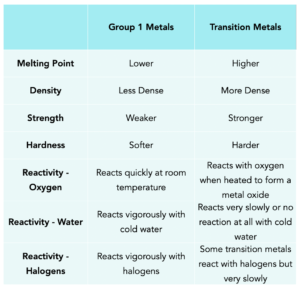The Transition Metals (GCSE Chemistry)
The Transition Metals
Transition Metals
Transition elements are metals that are found in the central block of the periodic table between Group 2 and Group 3. These are the elements that most people associate the world metal to such as copper, iron and silver.
During this tutorial we will be discussing the properties of transition metals. When we talk about transition metals, we will be focusing on the properties of chromium, manganese, iron, cobalt, nickel and copper.
The transition metals listed above have similar properties however are different from the alkali metals we discussed before. Below is a table comparing the properties between Group 1 and transition metals:

- Transition metals have more than one ion. Transition metals form ions with various charges. For example: Copper has 2 ions Cu+ or Cu2+ , Iron has 2 ions Fe2+ or Fe3+ and Cobalt has 2 ions Co2+ or Co3+.
- Transition metals can be used as catalysts. Transition metals can act as catalysts which means they increase the rate of reaction without being used in the reaction. For example an iron catalyst is used in the Haber process to produce ammonia.
Transition metals are a group of elements in the periodic table that have unique properties and are found in the middle of the table. They are characterized by having multiple valence electrons, which are electrons in the outermost shell that are involved in chemical reactions.
Transition metals have several unique properties, including high melting and boiling points, high densities, and the ability to form multiple ionic charges. They are also known for their bright and colorful compounds, as well as their ability to conduct electricity and heat.
Transition metals have many important uses in everyday life. Iron, for example, is used to make steel, which is used to build buildings, bridges, and vehicles. Copper is used to make electrical wiring and coins, while nickel is used in stainless steel and batteries.
Transition metals are essential in many industries, including construction, electronics, and transportation. They are used in the production of steel, aluminum, and other metals, as well as in the manufacturing of electronic components and batteries.
Transition metals form compounds by donating or accepting electrons from other elements. They are able to form multiple ionic charges, which allows them to form compounds with different properties and uses.
Transition metals are different from other metals in that they have multiple valence electrons and the ability to form multiple ionic charges. They also have unique properties, such as high melting and boiling points, high densities, and the ability to conduct electricity and heat.
Yes, transition metals can react with other elements, such as oxygen, to form compounds. These reactions can produce compounds with unique properties and uses.
Transition metals are called “transition” metals because they are in the transition between the metals in the main groups of the periodic table and the inner transition metals.
Scientists study transition metals through a variety of methods, including experiments, observations, and computational simulations. By studying the properties and behavior of these elements, they can gain a better understanding of their role in the periodic table and their importance in various industries.





Still got a question? Leave a comment
Leave a comment